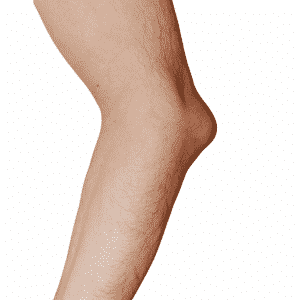
Olecranon bursitis showing swelling at tip of the elbow.
Before we answer the question “Can I drain my own elbow bursitis?” we need to explain what olecranon bursitis is. Olecranon bursitis is a condition caused by acute or chronic inflammation of the olecranon bursa, which is a thin fluid filled sac that lies under the skin at the tip of the elbow. It helps to reduce friction as the olecranon (tip of the elbow) and triceps tendon glide under the skin as the elbow straightens and bends.
When olecranon bursitis occurs, the bursa lining becomes inflamed and thickened, and the cells of the lining produce more fluid so the bursa swells. In an acute bursitis the bursa becomes thickened, inflamed, and swollen and can be associated with pain. The size of the bursa may increase or decrease and once the acute episode is over the bursa usually shrinks back to its original size. The elbow bursa may be recurrent so that the patient experiences brief flares of inflammation from time to time. However, in some cases the bursa can become persistently swollen even after the inflammation settles.
What are the causes of olecranon bursitis?
There are several causes, the most common cause we see in our clinics is repeated direct trauma from leaning on the tips of the elbow, generally due to work or certain sports. In some cases, trauma causes the bursa to swell, and bacteria can get in through broken skin and cause infection of the olecranon bursa.
An acute inflamed bursa that is infected will be painful and swollen with overlying skin redness. The pain and swelling may cause reduced elbow movement and patients may feel generally unwell and experience fevers, and redness may track up the arm towards the armpit as the infection spreads.
Other causes of recurrent olecranon bursitis include inflammatory conditions such as gout and rheumatoid arthritis. Chronic olecranon bursitis usually occurs after recurrent episodes and can be due to repeated direct trauma or systemic conditions such as gout.
How can I prevent elbow bursitis?
Most cases of elbow bursitis are from overuse, so the best treatment is prevention. It’s important to avoid or change activities that cause the problem:
- Adopt proper posture or technique for sports or work activities
- Use cushions and wear elbow pads when you put weight on your elbows
- Ease into new exercises or activities to avoid injury
- Take breaks when doing repetitive tasks
- Cleaning scratches or cuts on elbows to prevent infection
How is olecranon bursitis treated?
It is not uncommon for us to see patients who have been struggling to find the right olecranon bursitis treatment. In acute cases the focus is treating the inflammation. Patients can use home treatments including elbow ice packs (paid link), non-steroidal anti-inflammatory drugs (NSAIDs), to reduce inflammation, and avoiding leaning on the tip of the elbow.
One of the side effects of olecranon bursitis is that the pain limits movement and the elbow joint gets stiff easily, so it is important to keep the joint moving gently. As well as anti-inflammatory medications, your doctor may recommend physical therapy to work on muscle and joint motion. In some cases, a compression sleeve (paid link) may be applied to help reduce swelling. Compression sleeves should not be worn at night and should not be too tight.
In cases of infected olecranon bursitis, it is important to seek medical advice to treat the inflammation with antibiotics to control the infection. In severe cases of infection patients may need admission for intravenous antibiotics and rarely surgery may be needed if the bursa ruptures or infection is uncontrolled.
When chronic enlargement of the olecranon bursa occurs, surgery may be required to excise the bursa. This is an operation to remove the bursa from the back of the elbow. It is important to excise all the bursa tissue to prevent complications, and for this reason we don’t tend to operate on acutely inflamed cases. This operation can be performed under general anaesthetic, but we recommend that patients have this surgery done awake under regional anaesthetic.
After an excision of olecranon bursa, recovery is quick, patients can resume a desk-based job as soon as pain allows, and manual jobs can re-start once the stitches have been removed after 2 weeks. The main risk of olecranon excision surgery is haematoma/seroma from blood or tissue fluid filling the space where the bursa was removed. The pressure bandage reduces this risk. Other less common risks include wound healing problems, infection, and recurrence of swelling. If you are looking for olecranon bursitis treatment, please get in touch.
Can I drain my own elbow bursitis?
I frequently get asked online the question “can I drain my own elbow bursitis”. My answer: “Absolutely NOT!” Draining fluid from the bursa is done by aspiration, in which a needle is inserted through the skin into the bursa, then the excess fluid is sucked out. Aspiration removes fluid but doesn’t treat the cause of the bursitis so it is most likely that the bursal cells will continue to produce fluid and the swelling would recur. In worst case scenarios, putting a needle into the olecranon bursa to aspirate or inject the bursa can introduce bacteria into the bursa causing infection. Severe life-threatening infections have been reported after these procedures. For this reason, we do not recommend you drain your own elbow bursitis as draining the fluid, or injecting the bursa can have serious side effects.
Other elbow isses we treat:
As well as treating Olecranon Bursitis, we also treat:
Cubital tunnel syndrome is a condition that results from compression of the ulnar nerve at the back at the elbow which results in numbness in the little and ring fingers of the hand and weakness in the hand.
Tennis elbow is a degenerative, self-limiting condition of one of the tendons at the outside (lateral side) of the elbow which causes pain. Patients often experience lateral elbow pain with gripping or picking up objects. In severe cases there can be pain at rest.
Golfer’s elbow is a condition very similar to tennis elbow but affects the tendons on the inside (medial side) of the elbow.




